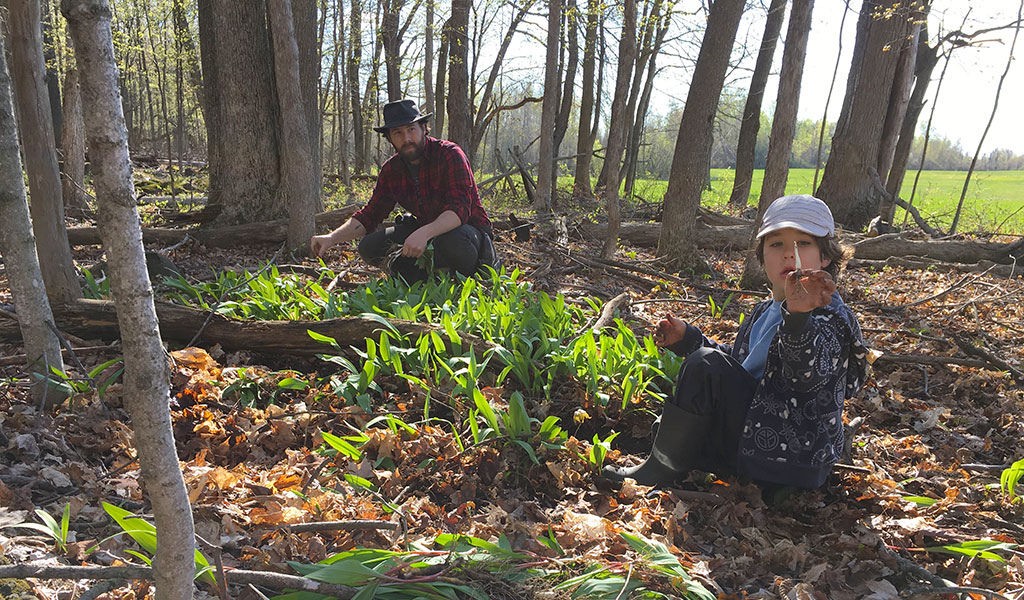Take fewer leeks

Emmett and Elliott having a good day in the leek patch. Photo of the Day archive: Martha Foley, Canton, NY
Friends and family understand that some of my dinners can be pretty wild. For example, right now they may include mashed sunchoke or “Jerusalem artichoke” tubers that escaped the voles and mice over the winter, as well as a steaming plate of tender, sweet nettles. (When cooked, the latter lose their sting, becoming tame as kittens. Better even, because they don’t shed.)
But the tastiest wild food around in very early spring is our native wild leek, Allium tricoccum, a.k.a. wild garlic, spring onion, or ramp (from “ramson,” a name for a similar European species). It pushes its light green leaves up through the leaf litter in hardwood forests along eastern North America, from Québec and Ontario south to South Carolina, in very early spring. They grow in clumps, occasionally forming large colonies which in some places carpet the forest floor. They last for only a few weeks, fading away by late June.
In terms of evolution, early-spring plants such as wild leeks and trout lilies, and to a lesser extent trilliums, have found a handy niche in the hardwood forest ecosystem. By emerging first they get their pick of nutrients contained in the melted snow before the competition wakes up. They are also assured of ample moisture before they become dormant. And because there are no leaves on overstory trees, they get lots of sunlight. Which is lucky for us, as a large swath of emerald-green wild leeks in full sun is really a marvel to behold.

A bunch of ramps, or wild leeks, at a farmer’s market. Commercial harvesting threatens the sustainability of this slowly maturing wild food. Photo: < a href=”https://commons.wikimedia.org/wiki/File:RampBunch.png”>MJ, Creative Commons, some rights reserved
The flavor of wild leeks is described as a mix of garlic and onion. The whole plant is typically dug up, roots included, and all parts of it are used. Its modest bulb is absent on young plants which are just emerging, but it matures by the time the plant fades. The bulb is used like garlic or onion, and some like it pickled. The broad leaf, similar in size and shape to those of lily or tulip, can be chopped fresh and used in salads, but it is usually cooked along with the scallion-like stem in a soup, stir-fry, omelet or other savory dish.
Allium tricoccumhas a long history of being harvested from the wild, and sold at markets or in grocery stores. With the advent of the “locavore” and “foodie” movements, wild leeks are in higher demand than ever. Unfortunately, this has put them at increased risk of being over-harvested at the same time their populations are fast dwindling.
One of the problems is that wild leeks reproduce very slowly, taking 5-7 years to fully mature and make seeds to complete their life cycle. Even the seeds take 2 years to germinate. In the words of Jacob Richler, writing for Maclean’s magazine in May 2014, “…wild leeks mature and breed about as efficiently as sharks.” The same article says that according to researchers in Quebec, harvesting more than 5% of the leeks annually in any given area is unsustainable.
In the province of Québec, wild leeks were nearly wiped out over large regions. Leeks are now listed as a threatened plant there, and a ban on commercial harvesting has been in place since 1995. Québec residents are only allowed to pick 50 plants a year for personal use. According to Andrée Nault, a researcher at the Montréal Biodôme, authorities seized 444,000 bulbs from poachers in 1999, which were (bulbs, not poachers) all planted by volunteers.
Portions of Tennessee and South Carolina are also subject to harvest bans as of 2004. On Federal forest land, a harvest permit is required to pick any amount of leeks. In New York State, it is legal to harvest wild leeks on NYS land, with the exception of a sub-species (so-called “Burdick’s leek”) in Chautauqua County.
However, a growing number of people are calling on New York State Department of Environmental Conservation officials to take steps to limit the harvest of wild leeks. Many conservation groups recommend not only limiting the harvest to 5% of a patch, but only taking the greens, which leaves the bulb to continue maturing the next year.
I do advocate enjoying wild foods, but when you’re out in the woods this spring, please think twice before taking a leek.
Paul Hetzler is a horticulture and natural resources educator with Cornell Cooperative Extension of St. Lawrence County.







